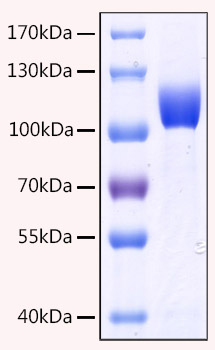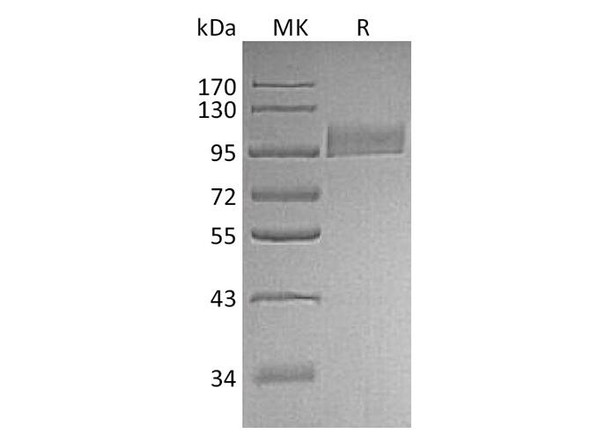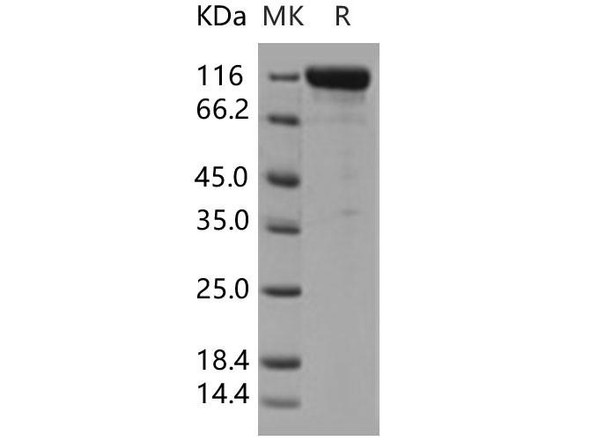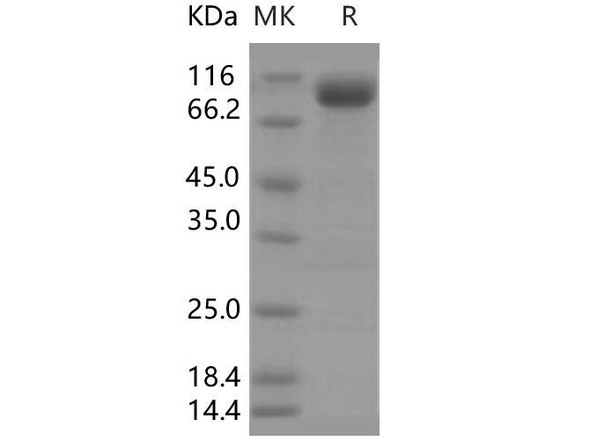Description
Recombinant Human MME/CD10 Protein
The Recombinant Human MME/CD10 Protein is a biologically active recombinant protein that plays a significant role in various cellular processes and signaling pathways in human biology. This protein is widely employed in immunological research, cell biology studies, protein-protein interaction analyses, and therapeutic development, providing researchers with a reliable tool for investigating MME/CD10 function and its implications in health and disease.
This product (SKU: RPCB1792) is produced using HEK293 Cells and features a N-His tag for convenient detection and purification. The protein exhibits a calculated molecular weight of 82.2 kDa with an observed molecular weight of 95-105 kDa under denaturing conditions, achieving ≥ 95 % as determined by SDS-PAGE.. Functional bioactivity has been validated through rigorous quality control assays, confirming its suitability for demanding research applications.
Key Features
| High Purity by Affinity Chromatography | |
| Mammalian & Bacterial Expression Systems | |
| High lot-to-lot consistency via strict QC |
| Product Name: | Recombinant Human MME/CD10 Protein |
| SKU: | RPCB1792 |
| Size: | 50 μg |
| Reactivity: | Human |
| Synonyms: | MME, EPN |
| Tag: | N-His |
| Expression Host: | HEK293 Cells |
| Calculated MW: | 82.2 kDa |
| Observed MW: | 95-105 kDa |
| Gene ID: | 4311 |
| Protein Description: | High quality, high purity and low endotoxin recombinant Recombinant Human MME/Neprilysin/CD10 Protein (RPCB1792), tested reactivity in HEK293 Cells and has been validated in SDS-PAGE.100% guaranteed. |
| Endotoxin: | < 1 EU/μg of the protein by LAL method. |
| Purity: | ≥ 95 % as determined by SDS-PAGE. |
| Formulation: | Lyophilized from a 0.22 μm filtered solution of 20mM MES, 100mM NaCl, 1mM ZnCl2, 10%glycerol, pH 6.5. |
| Bio-Activity: | Measured by its ability to cleave the fluorogenic peptide substrate, Mca-RPPGFSAFK (Dnp)-OH, (R&D Systems, Catalog # ES005). The specific activity is >1,500 pmoles/min/μg. |
| Reconstitution: | Centrifuge the vial before opening. Reconstitute to a concentration of 0.1-0.5 mg/mL in sterile distilled water. Avoid vortex or vigorously pipetting the protein. For long term storage, it is recommended to add a carrier protein or stablizer (e.g. 0.1% BSA, 5% HSA, 10% FBS or 5% Trehalose), and aliquot the reconstituted protein solution to minimize free-thaw cycles. |
| Storage: | Store at -20℃.Store the lyophilized protein at -20℃ to -80 ℃ up to 1 year from the date of receipt. After reconstitution, the protein solution is stable at -20℃ for 3 months, at 2-8℃ for up to 1 week. |
The cluster of differentiation (CD) system is commonly used as cell markers in Immunophenotyping. Different kinds of cells in the immune system can be identified through the surface CD molecules associating with the immune function of the cell. There are more than 320 CD unique clusters and subclusters have been identified. Some of the CD molecules serve as receptors or ligands important to the cell through initiating a signal cascade which then alters the behavior of the cell. Some CD proteins do not take part in the cell signal process but have other functions such as cell adhesion. The cluster of differentiation 10 (CD10), also known as Neprilysin and neutral endopeptidase, is a member of the CD system. CD10 is a zinc-dependent metalloprotease enzyme that had the function to degrade some small secreted peptides such as the amyloid beta-peptide. It exists as a membrane-bound protein and has a high concentration in kidney and lung tissues. Mutations in the CD10 gene can induce the familial forms of Alzheimer's disease, providing strong evidence for the protein's association with the Alzheimer's disease process. CD10 is also associated with other biochemical processes.







